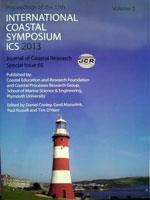Choi, J. K., Hyun Yang, H. J. Han, Ryu, J. H. and Park, Y.J., 2013. Quantitative estimation of the suspended sediment movements in the coastal region using GOCI
The Geostationary Ocean Color Imager (GOCI), the world's first geostationary ocean color observation satellite, is useful for monitoring the temporal dynamics of coastal water turbidity because it can obtain satellite images every hour during the daytime. Temporal variation in turbidity is the key to understanding sediment dynamics in coastal regions. For example, a certain patch of suspended sediment in surface water can be traced every hour by generating a GOCI- derived map of suspended sediment concentration (SSC). By calculating the variations in the position of the patch every hour quantitatively, we can obtain information on the current movement in the region quantitatively. Here, we investigate the applicability of GOCI data to monitoring of the temporal movement of suspended sediment in coastal areas and to the development of algorithms for calculating the current speed and direction. Our study was performed in areas near Gyeonggi Bay on the mid-west coast of the Korean Peninsula. Field work was performed to obtain in situ measurements of SSC and optical properties of the water surface. These data could then be combined to derive an SSC algorithm based on the relationship between the SSC and remote sensing reflectance (Rrs) values. We calculated the suspended sediment movement from hourly SSC images. Current velocity and direction were also measured in the field to validate and identify the calculated movement. GOCI images acquired on the same day as the samples were used to generate a map of turbidity and to estimate the differences in SSC displayed in each image. We found that GOCI could be effectively used to monitor the temporal dynamics of the turbidity of coastal waters, i.e., sediment movements driven by currents along the west coast of the Korean Peninsula. Sediment movements can be applied to develop GOCI-based algorithms that calculate current velocities and generate maps of current vectors in this coastal area.





